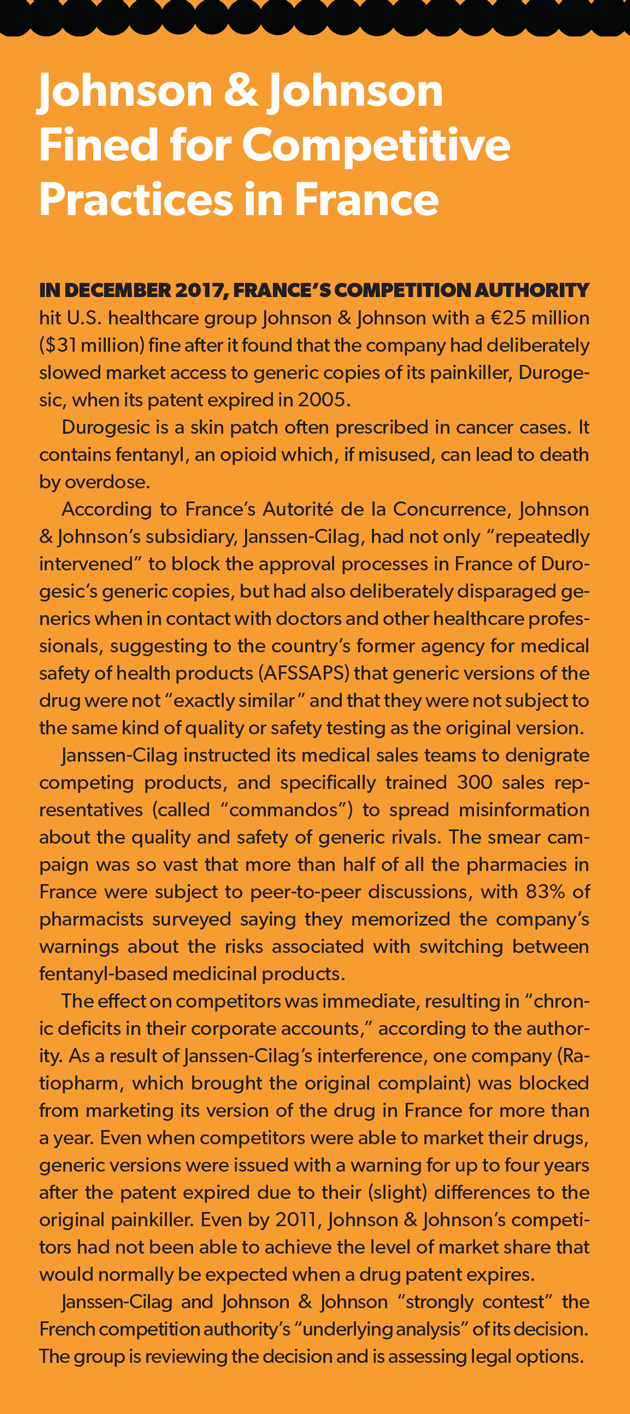Companies are increasingly coming under fire for unfair competitive practices and abuse of a dominant market position. What can they do to avoid costly fines and regulatory scrutiny?
In January, the European Commission fined Qualcomm, the world’s largest smartphone chip-maker, €997.4 million ($1.23 billion) for setting up a deal to be Apple’s sole chip supplier for five years. The Commission, which is the European Union’s executive body responsible for proposing and enforcing legislation and implementing policy, held that Qualcomm’s attempts to secure exclusive supply terms with the computer giant was an abuse of its dominant market position. Companies are considered to have a dominant position if their power in the market is such that they can operate without considering the interests of competitors, suppliers or customers. Between 2011 and 2016, the term of the arrangement, Qualcomm held a 90% share in the global market for long-term evolution (LTE) baseband chipsets, with manufacturing of iPhones and iPads leading Apple to account for one-third of the total demand.
The penalty imposed on Qualcomm equals 4.9% of its global revenues for 2017. (The maximum fine the commission can impose is 10%.) Aside from the fine, the commission also demanded that the company refrain from engaging in such practices (or those with a similar effect) in the future. Qualcomm, however, “strongly disagrees” with the decision and says it will appeal. Separately, the commission is also investigating Qualcomm over allegations of predatory pricing.
This is the third-largest penalty imposed by the European Commission for market abuse. Last year, it fined Google €2.42 billion ($2.99 billion) for promoting its own comparison shopping service over rivals through its search engine, and in 2009, it fined Intel €1.06 billion ($1.31 billion) for bullying customers into sourcing all their chips from the company. The U.S. Federal Trade Commission also launched similar investigations against Google and Intel (and agreed to settlements) for their antitrust practices and is currently investigating Qualcomm.
Inside the Qualcomm Case
Qualcomm first signed an exclusivity agreement with Apple in 2011, essentially agreeing to pay the computer company billions of dollars to ensure exclusive use of its chips. In 2013, this agreement was extended through 2016, covering a period of five-and-a-half years in total. Under the terms of the agreement, Qualcomm could cease payments if Apple launched a device with a chipset supplied by a rival, and seek reimbursement for a large proportion of previous payments for most of the time the agreement was in place. Internal documents reviewed by the European Commission show that Apple gave serious consideration to switching part of its baseband chipset sourcing to Intel (the largest supplier for chipsets used in computers). It held off on doing so until September 2016, however, when the agreement with Qualcomm was about to expire and the cost of switching under the terms of the agreement was reduced.
The commission’s investigation, which began in July 2015, looked at the extent of Qualcomm’s market presence; the size of the payments to Apple; evidence from Apple’s files of it “seriously” considering changing suppliers; and the importance for small companies of signing deals with Apple to show their legitimacy. After considering the evidence, EU Competition Commissioner Margrethe Vestager said “these payments…meant that no rival could effectively challenge Qualcomm in this market, no matter how good their products were. Qualcomm’s behavior denied consumers and other companies more choice and innovation.”
Other regulators around the world have also penalized Qualcomm for abusing its dominant position. In 2015, Qualcomm agreed to pay a $975 million fine for violating China’s anti-monopoly law. In December 2016, the company was fined $850 million in South Korea for unfair patent licensing, while last October, Taiwanese regulators fined it $774 million for violating antitrust rules. Last year, the U.S. Federal Trade Commission launched an investigation into the company’s pricing models over allegations that it charges partners unreasonable fees.
Defining Dominant Position
Complaints about unfair competitive practices among businesses have become more prominent in the past decade, and consumers, competitors and regulators have all raised concerns.
In EU member-states, competition law is enshrined in the Treaty on the Functioning of the European Union (TFEU). Article 102 of TFEU and Article 54 of the European Economic Area (EEA) Agreement both prohibit abuse of a dominant position. In the United States, such practices usually come under the umbrella provisions dealing with monopolies as set out under Section 2 of the Sherman Antitrust Act.
A dominant position is not in itself anti-competitive—it may just be that there are few operators working in the sector and that one company makes better products than its rivals. If a company exploits this position to eliminate competition, however, it is considered to have abused it.
Examples of abuse of dominant position include charging unreasonably high prices, depriving smaller competitors of customers by selling at artificially low prices that they cannot match, or forcing customers to buy bundles of products rather than just the one that is in greatest demand. Other practices that could be deemed abusive include refusing to deal with certain customers or offering special discounts to customers who buy all or most of their supplies from the dominant company.
There is no set percentage of market share that constitutes a dominant market position for a company. For example, if the market does not have high barriers to entry (such as huge manufacturing or excessive IP-related costs), a majority share of the market does not necessarily mean that the company has a dominant position.

In fact, even if a company controls less than half of the market, it can still be deemed to have a dominant position: The European Commission only rules out a company as having a dominant position if it has a market share of less than 25%. In 1999, for example, the European Commission found British Airways held a dominant position in the United Kingdom with just a 40% share of the market. Despite the relatively low percentage, dominance was established on the basis that British Airways’ market share was more than twice as large as the combined shares of its four largest competitors, it held substantially more slots at London’s Heathrow and Gatwick airports than other airlines, and it offered the largest range of flights into and out of the U.K.
According to experts, competition authorities can have an enormous amount of discretion about how they define a dominant position and whether it has been abused. “Even the term ‘market’ can be fluid,” said Jonathan Compton, dispute resolution and litigation partner at London law firm DMH Stallard. “Moreover, market dominance is also acceptable—it is not illegal for a company to have an overwhelming share of the market it operates in. The problem of abuse of dominant position arises surrounding the practices that a company uses to preserve that dominance, and what effect it has on competitors and consumers.”
Competition lawyers say that it can be difficult to determine what constitutes an abuse of dominant position. According to Adam Rooney, partner and anti-trust lawyer at London-based law firm Signature Litigation, “It is difficult to provide a checklist of what companies should and should not do to ensure that they are not abusing a dominant position because every case is measured on its own merits. Factors such as offering rebates to customers may be acceptable practice in one scenario, but an abuse in another. It depends on market share and how easy it is for other companies to enter the market.”
The key questions that companies need to consider are whether their behavior can be interpreted as exploitative or exclusionary. “The simplest test is to ask yourself what impact do these actions have on your competitors, and whether you would find these practices acceptable if your competitors were doing the same to you,” Rooney said. “If a company has any concerns either way, it should consult its legal teams as a first move.”
Another possible step, he said, is to go to the regulators and inquire—before any action is taken—as to what might constitute an abuse of dominant position or other unfair practice in a given scenario. “Many competition authorities have an arrangement whereby companies can ask them ‘informally’ if they might be in breach of competition law if they pursue a particular planned course of action, such as offering key clients rebates or reduced prices for exclusivity contracts,” Rooney said.
“Check with the authorities before you go ahead with the deal to get peace of mind about whether the company might be breaking the rules,” he added. “Fines for violations of competition law are going up worldwide, so it is great if you can get some kind of assurance from the regulator or enforcement agency that what you plan to do is acceptable.”
Avoiding Regulatory Scrutiny
Given the size of some of the harshest fines imposed for abuse of dominant position and other anti-competitive practices, it is important that companies review how aggressively they market their goods and services. While companies might not be able to rely on a checklist to look for signs of unfair practices, several kinds of behaviors should serve as “red flags” to alert companies to the fact that they might be engaging questionable practices.
Deliberately under-cutting competitors’ prices is a key one to watch, Compton said, even though it might look like the action benefits consumers. “Regulators see a lack of competition in the marketplace as being ultimately more detrimental to consumers in the long-term than higher prices might be in the short-term,” he said.
Limiting production to restrict supply is another practice that should be avoided, as is applying discriminatory pricing structures to different customers. Exclusivity contracts can also be an issue, particularly if they have punitive “refusal to supply” clauses in a market where few players can satisfy a customer’s demand.
To play it safe, Compton advised companies to review contracts annually to identify any areas where they might be overstepping. “Companies could be running a real risk if they have tied customers—particularly key customers—into five-year or long-term sales contracts,” he said. “The economic and market conditions that made that deal appealing and perhaps legitimate in 2015 may not be the same now, and the arrangement could be seen as being anti-competitive if reviewed through fresh eyes.”
Companies cannot become complacent. “Just because a company is allowed to make an exclusivity contract with a key customer in one market, does not mean that a regulator in a different market will see the arrangement in the same way,” Compton said. “The number of competitors and new market entrants varies from one country or region to the next, so what might be acceptable practice in the United States may be deemed anti-competitive and an abuse of dominant position in the EU.”

